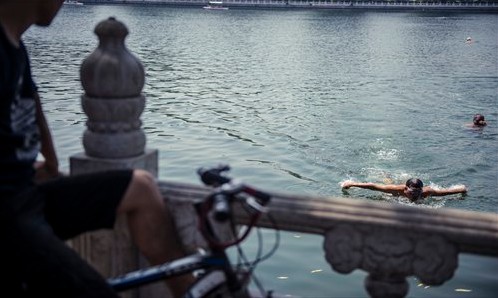
 |
| No longer a major commerce route, the Grand Canal's Houhai segment sees many swimmers. Photos: Li Hao/GT |
A dried up history
Major construction of the Grand Canal started in 486BC, during the Spring and Autumn Period (770BC-476BC) and ended in the 1290s under the rule of the Yuan Dynasty (1279-1368), according to History of Yuan, a text composed by the official bureau of the Ming Dynasty (1368-1644) in 1370. During the 1,800 years of construction, laborers and craftsmen completed the world's longest canal - nine times the length of the Suez Canal and 21 times that of the Panama Canal - using only simple tools and their bare hands.
The final stop and water gate of Beijing was Wanning Bridge in Di'anmen, Xicheng district. Though only some 10 meters long, this stone bridge decorated with white marble pillars once stood as the only entrance for ships and boats wanting to enter the capital.
Built during the rule of Kublai Khan (1215-1294), it divides the city and the Grand Canal, with the Yuhe River to the east and Shichahai to the west. When the Yuan Dynasty established Beijing as its capital, the city started to depend on the canal for its food supply.
The Tongyun Bridge in Zhangjiawan village, Tongzhou district, is another one of the few remaining architectural landmarks of the Grand Canal. According to the Beijing Municipal Commission of Tourism Development, this Ming Dynasty bridge was constructed in 1605, and is decorated with 36 stone lions, each with a different facial expression.
According to the Tongzhou district government's website, by 2010, close to 10 billion yuan ($1.50 billion, based on 2010 exchange rates) had been spent building up new, faux historic structures such as bridges around the Tongzhou segment of the canal.
Despite the money pumped into the project, the area is still far from well-known, and has nowhere near the tourist appeal of Wanning Bridge in the popular Houhai area.
And while both the Tongyun Bridge and Wanning Bridge have outlived the test of time, the majority of the architecture that once lined the Grand Canal has disappeared since the rise of modern transportation.
In their absence, the government has funded the construction of replicas built to mimic the ancient architecture. Walk just 400 meters east from the Wanning Bridge, and the freshly-made, government-constructed courtyards still give off the strong smell of wet paint.
Wang Jingwen, 68, lives close to Shichahai and said she doesn't understand the municipal government's decision to build copies of historic structures in the quest to become UNESCO-certified.
"The government claimed this is for the sake of the application ... for the Grand Canal. As a result, those who have been living here for generations were forced to leave. Their homes, the real, old hutong and courtyards, were replaced by expensive pseudo-classic architecture which no one can afford," she said.
"I don't get it," Wang continued. "Will the tourists really be attracted by these freshly built 'antiques'?"


















 People hold funeral for deceased relatives in quake-hit region
People hold funeral for deceased relatives in quake-hit region


![]()
